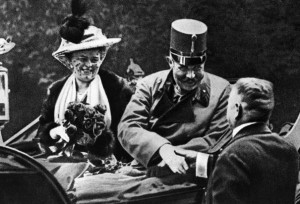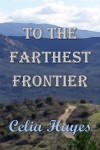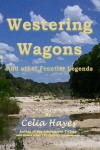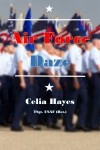Ho, hum – it’s Wednesday, so it must be time for another ruckus in the book world. This time it’s between one of the Big Five in traditional publishing, versus the retail Gargantua of Amazon. As near as I can make out, Hachette Book Group has their panties in a twist over the pricing of e-books, and how Amazon discounts print books for sale … oh, a pretty comprehensive account is here. Yes, it’s biased towards Amazon of course. Amazon is pretty good to those of us independent authors and small publishers. Which is not to say that they have not done some bone-headed and outright underhanded things in the past. But as it is, only the very, very, tippy-top of the pile in best-selling writers get anything like a fair shake from their publishers.
 This weekend marks the hundredth anniversary of the incident which was the spark that set off the cataclysm of the First World War. Which wasn’t, strictly speaking, the first world-wide war; it could be argued that the Napoleonic Wars were, and the interminable European war between France and England which spilled over into those colonies in the North American continent could also be considered a world war.
This weekend marks the hundredth anniversary of the incident which was the spark that set off the cataclysm of the First World War. Which wasn’t, strictly speaking, the first world-wide war; it could be argued that the Napoleonic Wars were, and the interminable European war between France and England which spilled over into those colonies in the North American continent could also be considered a world war.
The spark was seemingly a simple thing – almost a non-story as it appeared in the English and American newspapers; the assassination of an Austrian noble and his wife by a barely competent yet very lucky Serbian amateur terrorist. This was an appalling tragedy for the family of the Archduke Franz-Ferdinand and his beloved spouse, Sophie, the Countess Hohenberg, who left three living children to be raised by the Archduke’s best friend. The assassination was perhaps an inconvenience more than a tragedy to the the court and administration of Franz-Ferdinand’s uncle, the Emperor Franz Joseph. The Archduke, who but for the accident of birth would have been a rather quiet and dutiful nonentity, devoted to gardening, architecture and the hunt – was not a particularly popular man at the time of his death, either with his uncle, his fellow aristocrats or the Viennese public. He replaced the popular but suicidal Crown Prince Rudolph as heir, and had insisted on marrying for love, instead of merely making Sophie his mistress. They were eventually permitted to marry with the assurance that Sophie and her children would not have the standing or rights of succession. Sophie – lovely and well-tempered, conventionally pious, and well-educated – was usually treated pretty shabbily by Viennese society and by the imperial establishment on those official occasions at which the Archduke was expected to be present. Franz Ferdinand did play his part dutifully in official ceremonies and events, without any particular appearance of enjoyment. What started as a personal tragedy, and a national crisis for Austria-Hungary was merely the first fall in a train of dominoes.
The war which raged between 1914 and 1918 unleashed a whole cornucopia of horrors, being that they were waged between powers that had been fully or almost fully industrialized. It came after a hundred years of relative peace, prosperity and progress in the Western world. With the exception of the Franco-Prussian War, and the American Civil War, such wars as there had been were colonial wars, fought by small professional Western armies against relatively primitive foes. Many, especially in the educated classes in the late 19th century firmly believed that total, all-out, balls-to-the-wall war was something that the advanced nations of the West had moved away from, that the economic consequences would be so dire that the powers-that-be just wouldn’t allow it to happen. Meanwhile, European military planners moved briskly ahead, paying little attention to the main lesson to have been drawn from the American Civil War – that technology had moved far ahead of established tactics. The pump had also been primed by a series of little-recollected international crises at the end of the 19th and start of the 20th, which flamed up regularly in a sort of international patch of eczema, usually involving France, or Germany, England, Russia or Austria-Hungary or any combination. The crisis would be soothed by the hastily-applied salve of diplomacy … until the next time.
The one thing in common was that the great powers were jockeying for position, sometimes straight out, and sometimes through proxies. The author of the War That Ended Peace outlined how England and Germany came to stand against each other, having been allies more often than not in their previous history. Great Britain, a navy/sea power if there ever was one, gradually began a policy of more engagement in Europe among the great powers. Germany, a quintessential army/land power (and only unified into a single nation within living memory) developed the intention of having a serious deep-water navy.
And so they drifted into enmity. Once that first domino toppled, then all the rest came as a matter of course over the next four blood-soaked years. Treaty obligations and mobilization of the reserves imposed an iron rule. When the dominoes finished falling in 1918, three noble ruling houses had been cast down and a whole generation of of German, French, British and Russian men were gutted. The unwieldy empire to which the archduke had been heir-presumptive broke into its’ constituent parts, and all the bright promise of the modern world as seen by Europeans at the turn of the century before the last was reduced to a nightmare … and left us with wreckage that we are still sorting out, even after a hundred years. The past isn’t dead. It’s not even over.
(cross-posted on my book-blog, and at www.ncobrief.com.)
I went ahead and assembled various posts on historical incidents and famous – or not-so-famous people – this last weekend, and put it up on Amazon as a Kindle edition:

To The Farthest Frontier is a collection from the last year or so; featuring people like Dame Shirley Clappe, Billy the Kid, Tiberico Vasquez and the McCulloch brothers. I should have it up on Nook in a bit – these things take a bit of time and care to set up, and I get most sales for eBooks from Amazon anyway. So – priorities.
My previous collection, Westering Wagons is available, of course – other essays about the frontier, the Gold Rush, the emigrant experience and all: 
I have also made some other eBook collections of blog posts available on Amazon and Barnes & Noble. For instance – divers essays and reminiscences regarding my two decades in the Big Blue Air Force Machine: Air Force Daze

Travels With Blondie touches a little on my time in the military as well, since for sixteen years of it, I was also a single parent – and one with the inestimable good luck to be stationed overseas with my daughter. She was born in Japan (where I happened to be at the time) and was raised in Greece and Spain until we returned to the States more or less permanently when she was twelve years old. Yes, the culture shock was huge. 
And finally – there is a whole collection dedicated to Texas, The Heart of Texas which can be seen as a very extended footnote to the Adelsverein Trilogy. All of these individual essays and posts are widely scattered over in their original format over several websites and about a decades’ worth of archives, so having them all assembled and organized makes it much more convenient for the reader. 
We watched the final episode this week; the last of the season that I had never seen, even though I knew perfectly well what was supposed to happen during it. Still, it has been rather interesting, looking at the series, so many years later, charting the lives of an upper-class political family from the turn of the last century to the 1929 crash of the stock markets … and picking out, with a merciless eye, things like inauthentic costumes, hairstyles and attitudes. The fortunes of the series changed almost in reverse of the Bellamy fortunes; very much on a budget at first, then expanding; better and more historically correct costuming, more scenes shot out of doors, the characters jelled … well, some of them did. Others were just adjusted according to the needs of drama. Like Georgina, the ingénue turned battlefield nurse, who … turned into a frivolous flapper for the entire decade after the war in which she served? Just don’t see that; no matter how much she would have wanted to get back to something resembling normality after three years of hard and responsible work as a nurse … I just can’t see going on ten years of pleasure-seeking arrested development. A year or two to decompress, and then back to pursuing something, something earnest and useful, even marrying might have been more true to character and history … but the story arc dictated that Georgina be a Bright Young Thing for the duration of the season. And side note – my, did Anthony Andrews ever look so young! My daughter always loved the series with Jane Seymour where he played the Scarlet Pimpernel. Edward and Daisy – that was a bit more real, I think; she developing a spine of steel sufficient for both, but tactfully letting him take the lead publically, in most circumstances. Edward would have been a bit fragile, always – but Daisy would have looked after him in a way that wouldn’t have reminded him of that … except when it was the right time and in private.
Lord Bellamy was stalwart, and so was Hudson, in the tradition of Englishmen of that generation … of whom I can honestly say that I knew one example, very, very well – my paternal grandfather, a child and teenager of the Edwardian upper level working-class. (They were those who wore a proper 3-piece suit and polished shoes to do their work, of course – not the equivalent of boots with jeans and t-shirt.) Of course, his father – my great-grandfather, the gentleman’s gentleman, a valet and butler both –was thrusting into the middle class, thanks to a generous inheritance from his employer. The employer was fabulously wealthy, and left £600 to Great-Grandfather George in his will, sometime in the 1880s. GG-George must have been as treasured every bit as much as Hudson – and twice as canny, for he parlayed that inheritance into a society catering business and real estate, and eventually relocated to the New World. And Grandpa Alf reflected the values of his age, faultlessly, even down to the mustache and general bearing.
Anyway, back to Upstairs and Downstairs, and the world at the beginning of the last century: James – sigh. Self-involved to the end; a prime example of the truism that suicide is a hostile and passive-aggressive dagger directed at the heart of close kin and loved ones. I’ll show you – I’ll be dead and you’ll be sorry that you weren’t nicer to me, and didn’t live up to all my expectations of you! Impatient, unthinkingly, casually cruel – he was the sort of man, as my daughter observed – who was always after the next glittery, shiny object which attracted his interest, or the next glittery, shiny woman. Oh, charm and savoir-fair with bells on … but once achieved, he lost interest. Considerate of him to do the deed offstage and elsewhere than Eaton Place, but still … there still is something nastily passive-aggressive about his suicide.
Anyway – being done with this series, we are going on to watch Deadwood. Contrast much?
Never mind about the romance and all … dumpy and rather plain fifteen-year-olds, cursed with glasses and metal braces – still have a wistful affection for romance. Even if the prospective hero is at first meeting grumpy and impatient – even slightly mysterious. Someday, my fifteen-year old self hoped – I would go to Greece, or the South of France, although the romance part was perhaps a little bit too much to hope for.
And I did – but that is another story. At any rate, she and Rosemary Sutcliffe were among the first writers that I came back to, over and over – because of the way that they wrote about a place; every leaf and tree and flower of it. I would like to think that I have taken some lessons from them, or at least had their very good example before me when I began to write about specific places.


Recent Comments